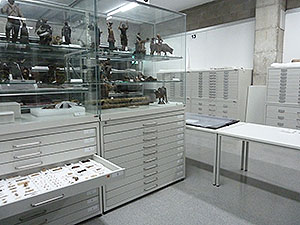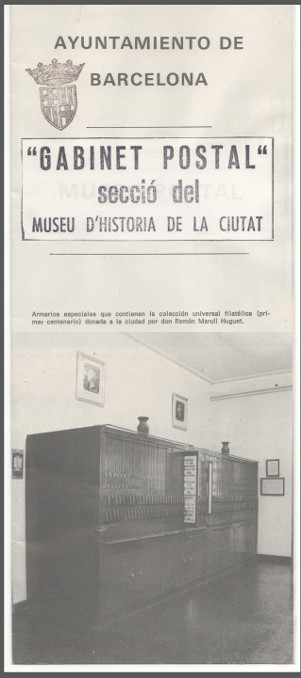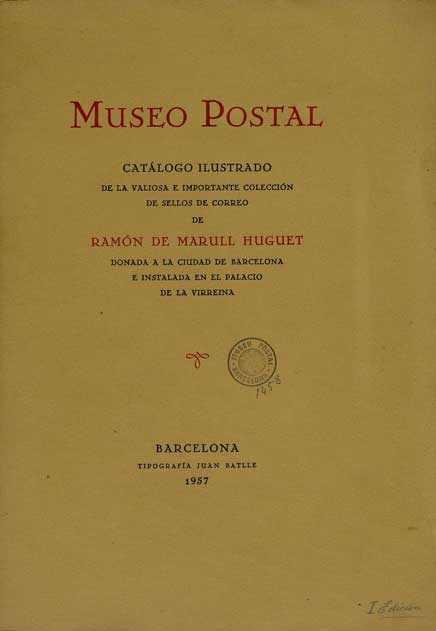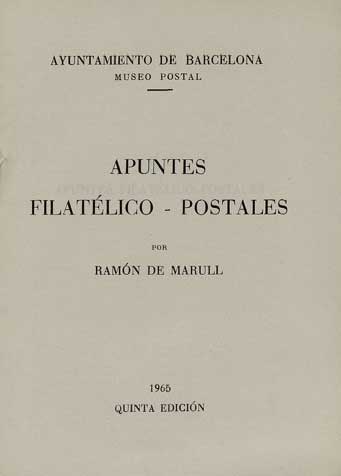
Ramon Marull’s collection was the origin and beginning of the Postal and Philatelic Museum of Barcelona, inaugurated on 8 September 1959. It took up three rooms in Virreina Palace.
The collection shows the first adhesive stamp in the world, issued by the United Kingdom of Great Britain and Ireland post service in 1840, known as “Penny Black”. It also shows the first issuances from other countries, including the “6 quarters” edited in Spain in 1850.

The building was erected between 1772 and 1777, and entrusted to Manuel d’Amat I de Junyent (1704-1782) in order to be his place of residence in Barcelona. Manuel d’Amat was viceroy of Peru during fourteen years (1761-1776). He married Maria Francesca Fivaller i Bru in 1779. His widow outlived him twelve years, living in the building, which started to be known as the Virreina Palace because of this fact.
By the middle of the 19th century the palace became property of Josep Carreras Argerich, former administrator of the family Amat, and it was acquired by the City Council of Barcelona in 1944 in order to turn it into a cultural equipment with exhibition rooms, and, mainly, into the headquarters of the Decorative Arts Museum (1949).
Aside from this museum, and before the Postal and Philatelic Museum opening, Virreina Palace already hosted the Cambó collection, which arrived to the city thanks to the politician in 1947. Later on, and provisionally, in 1980 it also became the headquarters of the Numismatic Cabinet of Catalonia, which is nowadays a section within the National Art Museum of Catalonia.
The collection of stamps donated by Ramon Marull was preserved in a big closet, according to the existent models in the Universal Postal Union in Bern. The Postal Union was created in 1878 as postage services meeting organisation in order to encourage the cooperation and execution of communal politics. At that moment it was the model to follow within the philatelic conservation.
This closet purchase cost, according to the Municipal Gazette of Barcelona on 6 April 1959, 92.000 pesetas. It was made of iron, glass and wood. Its triple nature as closet, strongbox and showcase allowed a flexible and safe search of stamps. It was only opened upon visitor request, so their exposition to the light and the sudden changes in weather and humidity were considerably reduced. The collection was presented organised in album sheets following an alphabetical order by countries and chronology.
Virreina Palace appointment as headquarters for the Cultural Department of Ajuntament de Barcelona in 1984 forced the restructuring of spaces not used as museum, and to locate the Postal Cabinet in other place, which was not achieved until 1990.

When the Postal Cabinet Museum of Barcelona arrived to Pedralbes Palace, the building already hosted other two museums: the Decorative Arts Museum (moved from Virreina Palace in 1985) and the Ceramics Museum (moved from the National Palace in 1990).
Pedralbes Palace was a present to King Alfonso XIII in 1926 from a group of aristocrats of Barcelona leaded by count Güell. It was an initiative at which, later on, Ajuntament de Barcelona was added. With the proclamation of the republic, the government donated it to the City Council, which, one year later, in 1932, handed it over to the Museums Board to open the Decorative Arts Museum. When the Civil war ended, the building became the official residence of General Francisco Franco and senior dignitaries during their visits to Barcelona. With the return of the democracy, the Palace returned to the City Council hands, which used part of the building on museums.
It was expected that the Postal Cabinet Museum of Barcelona would be placed at the first floor, taking up an extension of a bit more than 167m2 (45m2 intended for the library, 26m2 for offices and 96m2 for a permanent exhibition room). But this was not done and the museum remained closed, and the collection stocked within the palace store.
The closing meant the disappearance of the Postal Cabinet Museum from the public scene, and Ramon Marull’s collection included with it. As a consequence, it also meant the stopping of the increase of collections and the specialised study of its contents.

In 2008, Barcelona was chosen as headquarters for the Secretary General of the Union for the Mediterranean, and Pedralbes Palace was the building appointed to host it in 2009. That was why Marull’s collection had to be moved again. Its current location is the Centre of Conservation and Restoration, which depends on the Cultural Institute of Barcelona. The transfer took place following the professional normative and according to preventive conservation criteria, appropriate in order to guarantee its preservation.
After assuring its conservation, a revision project concerning the philatelic contents began, which main objective was to make it deeply known. It consisted on making the inventory and documentation of the 65.380 stamps donated, and on making the collection accessible through Internet.
The ongoing project plans a duration of five years, from 2011 to 2016. The online access to the collection’s contents will allow the monitoring of the project’s development, and the information will be updated monthly.

The museum suffered different name changes although its short life.
At the beginning, before the inauguration, it was going to be named Philatelic Museum (Museu Filatèlic), but the addition of materials related to the postal world (historical documentation and pre-philately) made more appropriate to name it Postal and Philatelic Museum of Barcelona (Museu Postal i Filatèlic de Barcelona)
In 1982, when it was agreed that it will be part of a section in the Historical Museum of the City (Museu d’Historia de la Ciutat), together with Verdaguer Museum, Distinguished Catalans Gallery and the Numismatic Cabinet, it changed again its name for Postal Cabinet.
Finally, in 1987 received as name Postal Cabinet Museum of Barcelona (MGPB) (Museu Gabinet Postal de Barcelona)

It is a little and simple publication realised by Ramon Marull and published in 1962 gathering the collection’s catalogue using an expert and philatelic point of view.
It contains a quantifying and a description about the collected fund, an index of its geographical origin, the chronology and photographs of a large part of the stamps. This little catalogue clearly illustrates the specialised broadcasting nature that Ramon Marull wanted for his collection.
Attracts our attention his special care when explaining the suitable environmental conditions for the stamps conservation, not very usual at his time. He wrote little sections titles: Why are so brief the philatelic expositions/exhibitions? or Inappropriateness of damp to excessively dry climate.
But, above all, it is convenient to highlight that Marull reaffirms and underlines the great pedagogical capacity of the collection. In his own words: “[…]they let us know all the existent countries and the ones which have been absorbed or annexed by other states, transformed in colonies, protectorates or provinces; forms of government or political regime; monetary systems; world personalities; geography, geology, social and political history, flora and fauna; landscapes and monuments and all kind of countries […]”

This will to disclose the world of the stamps expressed by Ramon Marull in the illustrated catalogue has a new continuation in a second publication, far less known, little and simple, but extremely illustrating his collector character and his passion.
The Philatelic Postal-notes, is a group of notes written by Marull intended to help everyone interested on philately and to contribute to its knowledge. He talks in it about the most valued collections, the collectors, the traders, the philatelic framework, the philatelic and postal congresses, etc.
The publication of theses noted dates from 1962, and three years later was published a fifth edition. It was thought that this Philatelic Postal-notes would lead to an own publication politics which would favour to place the Museum amongst the most prestigious within its field.